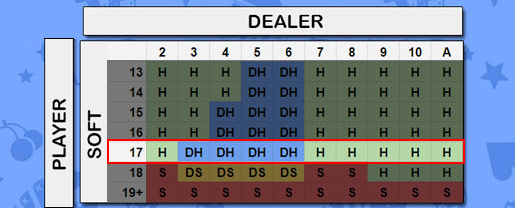How to Play a Soft 17 in Blackjack

From an outsider’s point of view, the game of blackjack is deceptively simple. But don’t be fooled; there is, in fact, a whole lot more to the game of blackjack than meets the eye. It takes practice to truly master the game, and before you hit the blackjack tables at your local casino, we suggest you play a few rounds online.
Best Casinos
However, if you want the best chance of winning a game of blackjack, you need to understand and utilise the blackjack strategy chart. And in order to fully understand the blackjack strategy chart, you’ll need a firm grip on all the different terms associated with it. In this article, we’re going to a closer look at the term ‘soft 17’ and explain how best to play a soft 17. Are you ready? Let’s go.
How to Recognise a Soft 17
In order to recognise whether or not you have a soft 17, you first need to understand the value of each card. The number cards from 2 to 10 retain their face value. The picture cards -Jack, Queen and King- have a value of 10. The Ace has a value of both one and eleven. It is the value of the Ace that is the most important element of the soft 17. Due to the fact that the Ace can be used as either having a value of one or a value of 11, it gives the player holding the Ace a lot more leeway when it comes to ‘hitting’.
Value of cards
- Ace = 11 or 1
- K, Q, J and 10 = 10p
- 2 – 9 = face value (example: 6 of spades = 6p)
A soft 17, therefore, is when you are dealt an Ace card and a number card that has a value of 6.
An Ace plus a 6 = 17 (think 11 + 6), but an Ace plus a 6 can also equal 7 (think 1 + 6) – this is why we call it a soft 17, because it can be played either way. A soft 17 can also be made up of 3 cards: An Ace, a 3 and 3, for example, also equals 17 or 7.
Examples of soft 17 hands
- Ace + 6 ( is either 11 + 6 = 17 or 1 + 6 = 7)
- Ace + 2 + 4 ( is either 11 + 2 + 4 = 17 or 1 + 2 + 4 = 7)
- Ace + 2 + 2 + 2 ( is either 11 + 2 + 2 + 2 = 17 or 1 + 2 + 2 + 2 = 7)
Moves to Make with A Soft 17

In the game of blackjack, the players hand is dealt face up. The dealer’s cards, however, are dealt with one card face up and one card face down. You must base any decisions you make about how best to play your hand on the dealer’s face up card. Confused? Don’t worry, it’s actually not that complicated, but is does highlight the importance of using the blackjack strategy chart.
If you have a soft 17, you should hit. Never stick. You should hit if the dealers face up card is an Ace or has a value of 7 through to 10. Don’t be afraid to take another card. If you stick, your soft 17 will be a wasted opportunity.
However, there is an alternative to hitting, and that alternative is the Double Down. If the dealer’s face up card is a number card from 2 to 6, the best move that you can make is to ‘double down’. To double down is to double your bet at that moment, but it means that you will only be dealt one more card. You do this because the dealer’s face up card is so low that your chances of winning the hand improve considerably.
Bad Luck
Unfortunately, if luck is against you, then no matter what moves you make you’re going to lose -winning is never guaranteed. Here’s what could go wrong:
Let’s say that the dealer’s face up card is a 6 and you decide to double down on a soft 17. The next card you’re dealt is a 10 or a picture card. This means that the final value of your hand is a hard 17 (1 + 6 + 10 = 17). You cannot take another card because you chose to double down. At this point, the dealer reveals their face down card and it’s a 9, giving the dealer a total of 15 (9 + 6 = 15). The dealer then has to hit. If the dealer is lucky enough to get a 3, 4, 5 or 6, their hand will beat your hand and you will have lost double the amount that you bet in the first place.
Good Luck
If Lady Luck is on your side, and you make the right moves, you could be onto a winner. Check out this scenario that would see you win the hand:
You have a soft 17 and the dealer’s card is an 8. You hit on your soft 17, and the card you receive is a 3. Your total is now 20 (17 + 3) or your total is 10 (7 + 3 = 10). If the dealer’s face down card is anything from a 2 to an 8, the dealer has to hit. In this example, let’s say the dealer has a 7 (total 15) and the dealer’s next card is a 4. The dealer now has a total of 19 (8 + 7 + 4 = 19). Now it’s your turn to hit again, which you can do because even if you get a card with a value of 10, your hand will still be valued at 20. If the dealer hits again and gets a 3 or above, taking their total over and above 21, you win.
Relevant news
How Can I Identify a Reliable Online Casino?
When navigating the vast realm of online casinos, you may come across enticing offers that…
How Can I Withdraw Money From My Casino Winnings?
When it comes to cashing out your casino winnings, think of it as navigating a…
What Are the Best Tactics to Win in Casino Games?
When it comes to navigating the labyrinth of casino games, think of yourself as a…
How to Play Craps?
Craps, often seen as a complex and daunting game, can actually be quite straightforward once…
What Is the Best Strategy for Playing Blackjack?
When it comes to playing blackjack, navigating the game is akin to peeling back the…

Game reviews with RTP in focus
If there's one thing we enjoy more than thrilling slot games, it's slot games that…







